International Finance Assignment: BHP, Bruin, Beacon, UniSuper
VerifiedAdded on 2022/12/29
|13
|3328
|40
Homework Assignment
AI Summary
This document provides a comprehensive solution to an international finance assignment, addressing key concepts and scenarios across multiple chapters. Chapter 3 analyzes how Citigroup can facilitate BHP Billiton's flow of funds, identifying relevant financial markets and optimal currency choices for a British subsidiary's loan. Chapter 5 examines factors affecting exchange rates for Bruin Aircraft, Pty Ltd. Chapter 6 explores scenarios for Beacon Lighting, including cost savings and currency risks associated with its relationship with Alibaba. Finally, Chapter 7 delves into UniSuper's investment strategies, including covered interest arbitrage and the associated risks of investing in Poland. The document offers detailed explanations, calculations, and analyses to provide a complete understanding of the assignment's requirements.
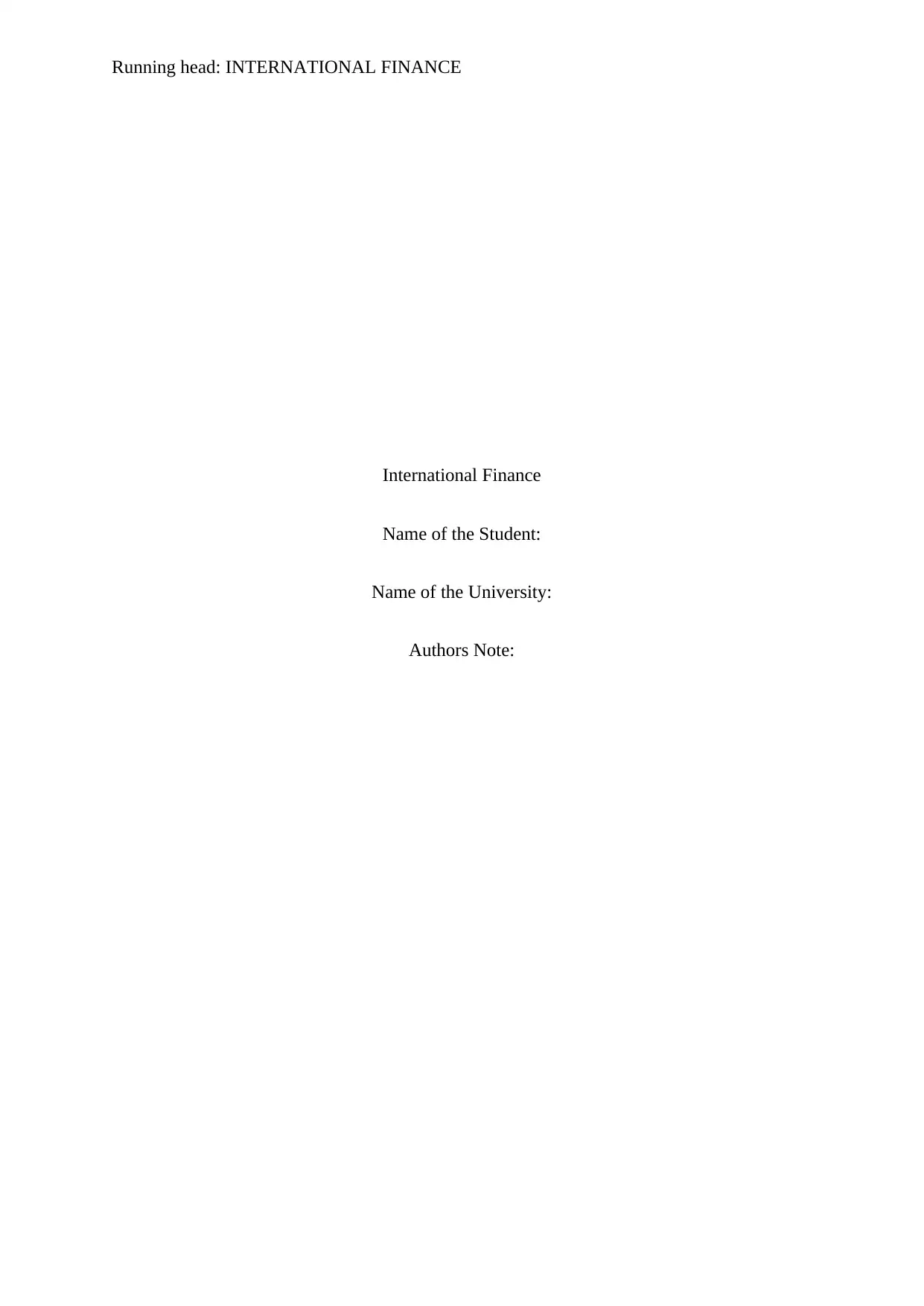
Running head: INTERNATIONAL FINANCE
International Finance
Name of the Student:
Name of the University:
Authors Note:
International Finance
Name of the Student:
Name of the University:
Authors Note:
Paraphrase This Document
Need a fresh take? Get an instant paraphrase of this document with our AI Paraphraser
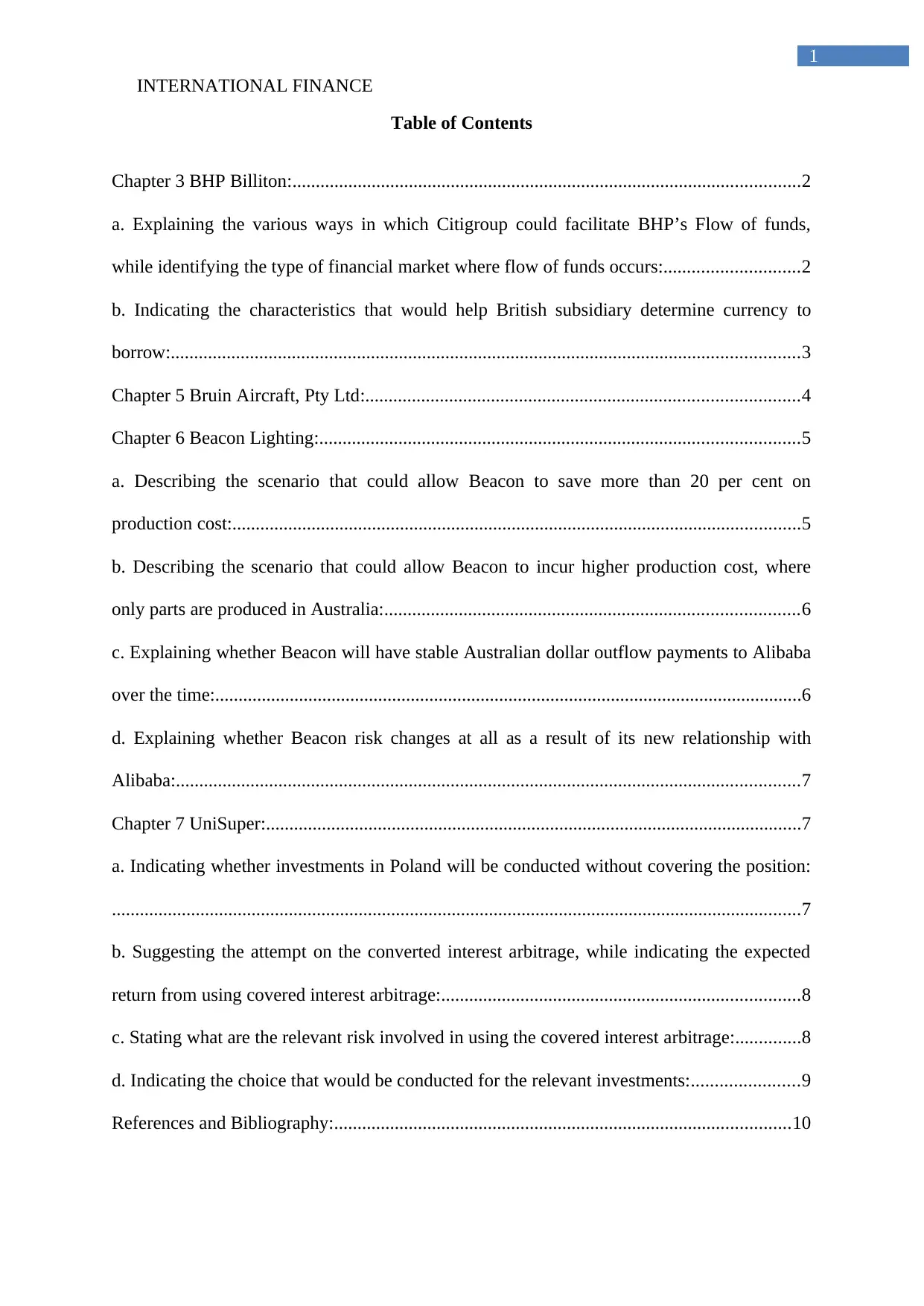
INTERNATIONAL FINANCE
1
Table of Contents
Chapter 3 BHP Billiton:.............................................................................................................2
a. Explaining the various ways in which Citigroup could facilitate BHP’s Flow of funds,
while identifying the type of financial market where flow of funds occurs:.............................2
b. Indicating the characteristics that would help British subsidiary determine currency to
borrow:.......................................................................................................................................3
Chapter 5 Bruin Aircraft, Pty Ltd:.............................................................................................4
Chapter 6 Beacon Lighting:.......................................................................................................5
a. Describing the scenario that could allow Beacon to save more than 20 per cent on
production cost:..........................................................................................................................5
b. Describing the scenario that could allow Beacon to incur higher production cost, where
only parts are produced in Australia:.........................................................................................6
c. Explaining whether Beacon will have stable Australian dollar outflow payments to Alibaba
over the time:..............................................................................................................................6
d. Explaining whether Beacon risk changes at all as a result of its new relationship with
Alibaba:......................................................................................................................................7
Chapter 7 UniSuper:...................................................................................................................7
a. Indicating whether investments in Poland will be conducted without covering the position:
....................................................................................................................................................7
b. Suggesting the attempt on the converted interest arbitrage, while indicating the expected
return from using covered interest arbitrage:.............................................................................8
c. Stating what are the relevant risk involved in using the covered interest arbitrage:..............8
d. Indicating the choice that would be conducted for the relevant investments:.......................9
References and Bibliography:..................................................................................................10
1
Table of Contents
Chapter 3 BHP Billiton:.............................................................................................................2
a. Explaining the various ways in which Citigroup could facilitate BHP’s Flow of funds,
while identifying the type of financial market where flow of funds occurs:.............................2
b. Indicating the characteristics that would help British subsidiary determine currency to
borrow:.......................................................................................................................................3
Chapter 5 Bruin Aircraft, Pty Ltd:.............................................................................................4
Chapter 6 Beacon Lighting:.......................................................................................................5
a. Describing the scenario that could allow Beacon to save more than 20 per cent on
production cost:..........................................................................................................................5
b. Describing the scenario that could allow Beacon to incur higher production cost, where
only parts are produced in Australia:.........................................................................................6
c. Explaining whether Beacon will have stable Australian dollar outflow payments to Alibaba
over the time:..............................................................................................................................6
d. Explaining whether Beacon risk changes at all as a result of its new relationship with
Alibaba:......................................................................................................................................7
Chapter 7 UniSuper:...................................................................................................................7
a. Indicating whether investments in Poland will be conducted without covering the position:
....................................................................................................................................................7
b. Suggesting the attempt on the converted interest arbitrage, while indicating the expected
return from using covered interest arbitrage:.............................................................................8
c. Stating what are the relevant risk involved in using the covered interest arbitrage:..............8
d. Indicating the choice that would be conducted for the relevant investments:.......................9
References and Bibliography:..................................................................................................10
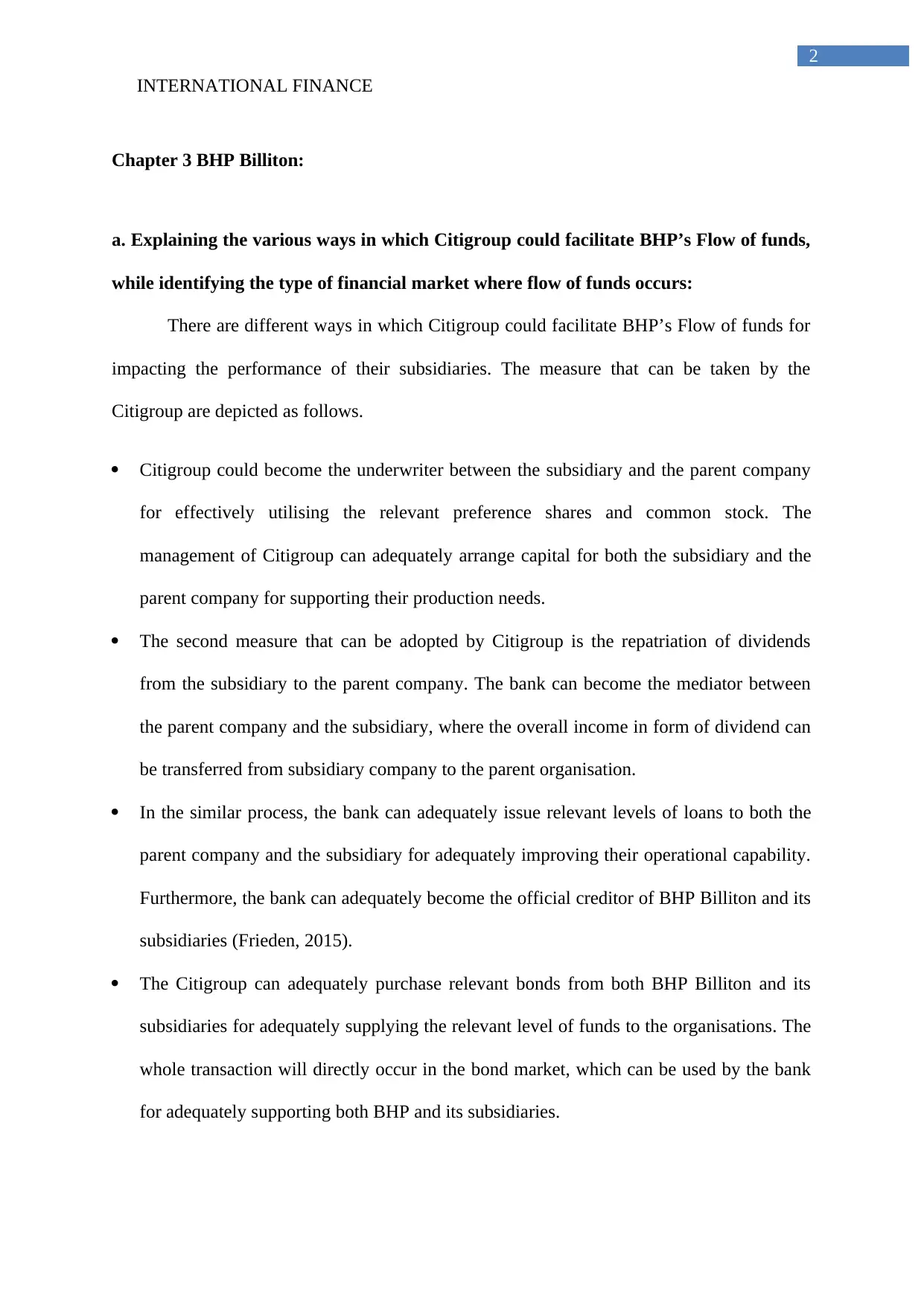
INTERNATIONAL FINANCE
2
Chapter 3 BHP Billiton:
a. Explaining the various ways in which Citigroup could facilitate BHP’s Flow of funds,
while identifying the type of financial market where flow of funds occurs:
There are different ways in which Citigroup could facilitate BHP’s Flow of funds for
impacting the performance of their subsidiaries. The measure that can be taken by the
Citigroup are depicted as follows.
Citigroup could become the underwriter between the subsidiary and the parent company
for effectively utilising the relevant preference shares and common stock. The
management of Citigroup can adequately arrange capital for both the subsidiary and the
parent company for supporting their production needs.
The second measure that can be adopted by Citigroup is the repatriation of dividends
from the subsidiary to the parent company. The bank can become the mediator between
the parent company and the subsidiary, where the overall income in form of dividend can
be transferred from subsidiary company to the parent organisation.
In the similar process, the bank can adequately issue relevant levels of loans to both the
parent company and the subsidiary for adequately improving their operational capability.
Furthermore, the bank can adequately become the official creditor of BHP Billiton and its
subsidiaries (Frieden, 2015).
The Citigroup can adequately purchase relevant bonds from both BHP Billiton and its
subsidiaries for adequately supplying the relevant level of funds to the organisations. The
whole transaction will directly occur in the bond market, which can be used by the bank
for adequately supporting both BHP and its subsidiaries.
2
Chapter 3 BHP Billiton:
a. Explaining the various ways in which Citigroup could facilitate BHP’s Flow of funds,
while identifying the type of financial market where flow of funds occurs:
There are different ways in which Citigroup could facilitate BHP’s Flow of funds for
impacting the performance of their subsidiaries. The measure that can be taken by the
Citigroup are depicted as follows.
Citigroup could become the underwriter between the subsidiary and the parent company
for effectively utilising the relevant preference shares and common stock. The
management of Citigroup can adequately arrange capital for both the subsidiary and the
parent company for supporting their production needs.
The second measure that can be adopted by Citigroup is the repatriation of dividends
from the subsidiary to the parent company. The bank can become the mediator between
the parent company and the subsidiary, where the overall income in form of dividend can
be transferred from subsidiary company to the parent organisation.
In the similar process, the bank can adequately issue relevant levels of loans to both the
parent company and the subsidiary for adequately improving their operational capability.
Furthermore, the bank can adequately become the official creditor of BHP Billiton and its
subsidiaries (Frieden, 2015).
The Citigroup can adequately purchase relevant bonds from both BHP Billiton and its
subsidiaries for adequately supplying the relevant level of funds to the organisations. The
whole transaction will directly occur in the bond market, which can be used by the bank
for adequately supporting both BHP and its subsidiaries.
⊘ This is a preview!⊘
Do you want full access?
Subscribe today to unlock all pages.

Trusted by 1+ million students worldwide
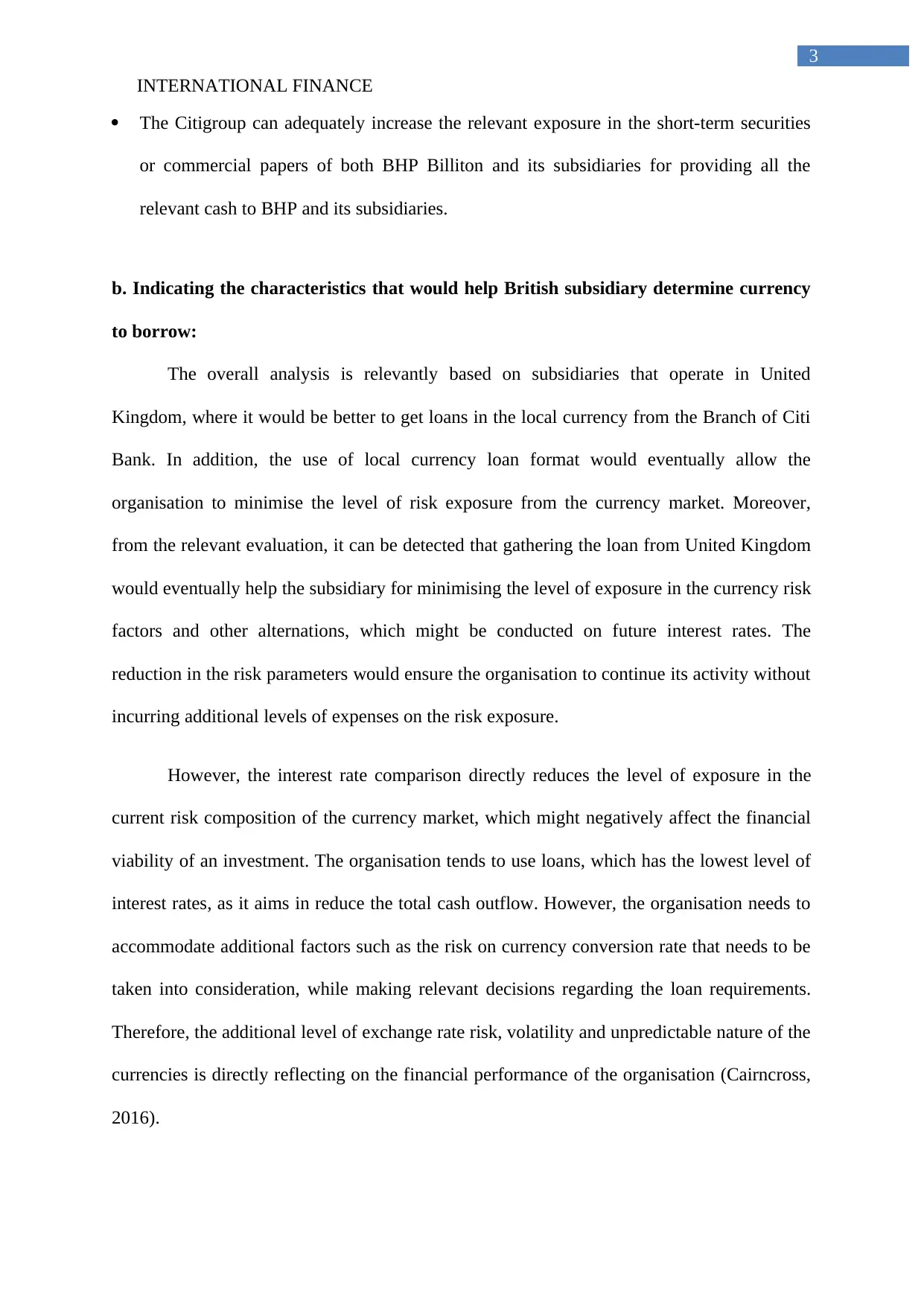
INTERNATIONAL FINANCE
3
The Citigroup can adequately increase the relevant exposure in the short-term securities
or commercial papers of both BHP Billiton and its subsidiaries for providing all the
relevant cash to BHP and its subsidiaries.
b. Indicating the characteristics that would help British subsidiary determine currency
to borrow:
The overall analysis is relevantly based on subsidiaries that operate in United
Kingdom, where it would be better to get loans in the local currency from the Branch of Citi
Bank. In addition, the use of local currency loan format would eventually allow the
organisation to minimise the level of risk exposure from the currency market. Moreover,
from the relevant evaluation, it can be detected that gathering the loan from United Kingdom
would eventually help the subsidiary for minimising the level of exposure in the currency risk
factors and other alternations, which might be conducted on future interest rates. The
reduction in the risk parameters would ensure the organisation to continue its activity without
incurring additional levels of expenses on the risk exposure.
However, the interest rate comparison directly reduces the level of exposure in the
current risk composition of the currency market, which might negatively affect the financial
viability of an investment. The organisation tends to use loans, which has the lowest level of
interest rates, as it aims in reduce the total cash outflow. However, the organisation needs to
accommodate additional factors such as the risk on currency conversion rate that needs to be
taken into consideration, while making relevant decisions regarding the loan requirements.
Therefore, the additional level of exchange rate risk, volatility and unpredictable nature of the
currencies is directly reflecting on the financial performance of the organisation (Cairncross,
2016).
3
The Citigroup can adequately increase the relevant exposure in the short-term securities
or commercial papers of both BHP Billiton and its subsidiaries for providing all the
relevant cash to BHP and its subsidiaries.
b. Indicating the characteristics that would help British subsidiary determine currency
to borrow:
The overall analysis is relevantly based on subsidiaries that operate in United
Kingdom, where it would be better to get loans in the local currency from the Branch of Citi
Bank. In addition, the use of local currency loan format would eventually allow the
organisation to minimise the level of risk exposure from the currency market. Moreover,
from the relevant evaluation, it can be detected that gathering the loan from United Kingdom
would eventually help the subsidiary for minimising the level of exposure in the currency risk
factors and other alternations, which might be conducted on future interest rates. The
reduction in the risk parameters would ensure the organisation to continue its activity without
incurring additional levels of expenses on the risk exposure.
However, the interest rate comparison directly reduces the level of exposure in the
current risk composition of the currency market, which might negatively affect the financial
viability of an investment. The organisation tends to use loans, which has the lowest level of
interest rates, as it aims in reduce the total cash outflow. However, the organisation needs to
accommodate additional factors such as the risk on currency conversion rate that needs to be
taken into consideration, while making relevant decisions regarding the loan requirements.
Therefore, the additional level of exchange rate risk, volatility and unpredictable nature of the
currencies is directly reflecting on the financial performance of the organisation (Cairncross,
2016).
Paraphrase This Document
Need a fresh take? Get an instant paraphrase of this document with our AI Paraphraser
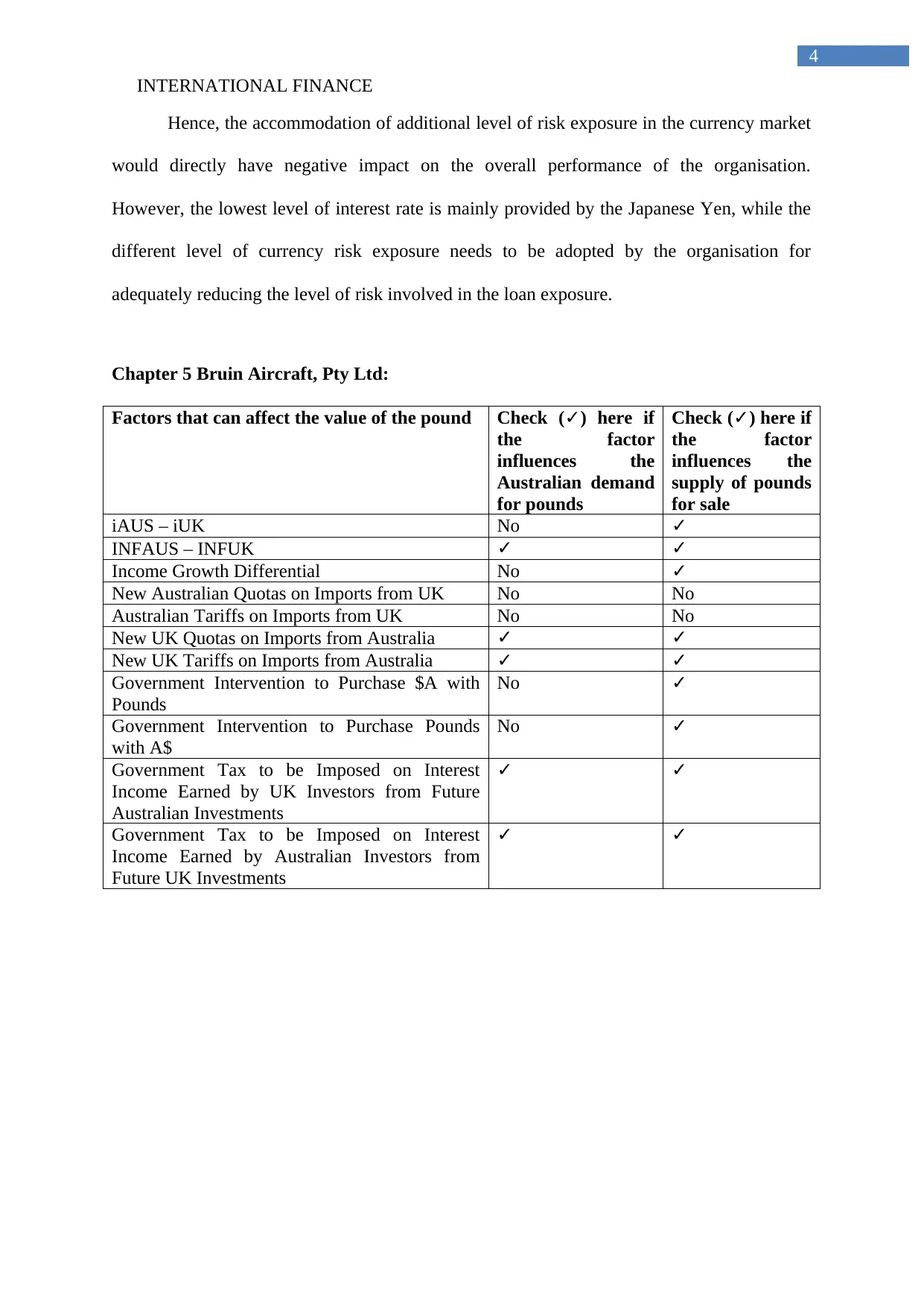
INTERNATIONAL FINANCE
4
Hence, the accommodation of additional level of risk exposure in the currency market
would directly have negative impact on the overall performance of the organisation.
However, the lowest level of interest rate is mainly provided by the Japanese Yen, while the
different level of currency risk exposure needs to be adopted by the organisation for
adequately reducing the level of risk involved in the loan exposure.
Chapter 5 Bruin Aircraft, Pty Ltd:
Factors that can affect the value of the pound Check (✓) here if
the factor
influences the
Australian demand
for pounds
Check (✓) here if
the factor
influences the
supply of pounds
for sale
iAUS – iUK No ✓
INFAUS – INFUK ✓ ✓
Income Growth Differential No ✓
New Australian Quotas on Imports from UK No No
Australian Tariffs on Imports from UK No No
New UK Quotas on Imports from Australia ✓ ✓
New UK Tariffs on Imports from Australia ✓ ✓
Government Intervention to Purchase $A with
Pounds
No ✓
Government Intervention to Purchase Pounds
with A$
No ✓
Government Tax to be Imposed on Interest
Income Earned by UK Investors from Future
Australian Investments
✓ ✓
Government Tax to be Imposed on Interest
Income Earned by Australian Investors from
Future UK Investments
✓ ✓
4
Hence, the accommodation of additional level of risk exposure in the currency market
would directly have negative impact on the overall performance of the organisation.
However, the lowest level of interest rate is mainly provided by the Japanese Yen, while the
different level of currency risk exposure needs to be adopted by the organisation for
adequately reducing the level of risk involved in the loan exposure.
Chapter 5 Bruin Aircraft, Pty Ltd:
Factors that can affect the value of the pound Check (✓) here if
the factor
influences the
Australian demand
for pounds
Check (✓) here if
the factor
influences the
supply of pounds
for sale
iAUS – iUK No ✓
INFAUS – INFUK ✓ ✓
Income Growth Differential No ✓
New Australian Quotas on Imports from UK No No
Australian Tariffs on Imports from UK No No
New UK Quotas on Imports from Australia ✓ ✓
New UK Tariffs on Imports from Australia ✓ ✓
Government Intervention to Purchase $A with
Pounds
No ✓
Government Intervention to Purchase Pounds
with A$
No ✓
Government Tax to be Imposed on Interest
Income Earned by UK Investors from Future
Australian Investments
✓ ✓
Government Tax to be Imposed on Interest
Income Earned by Australian Investors from
Future UK Investments
✓ ✓
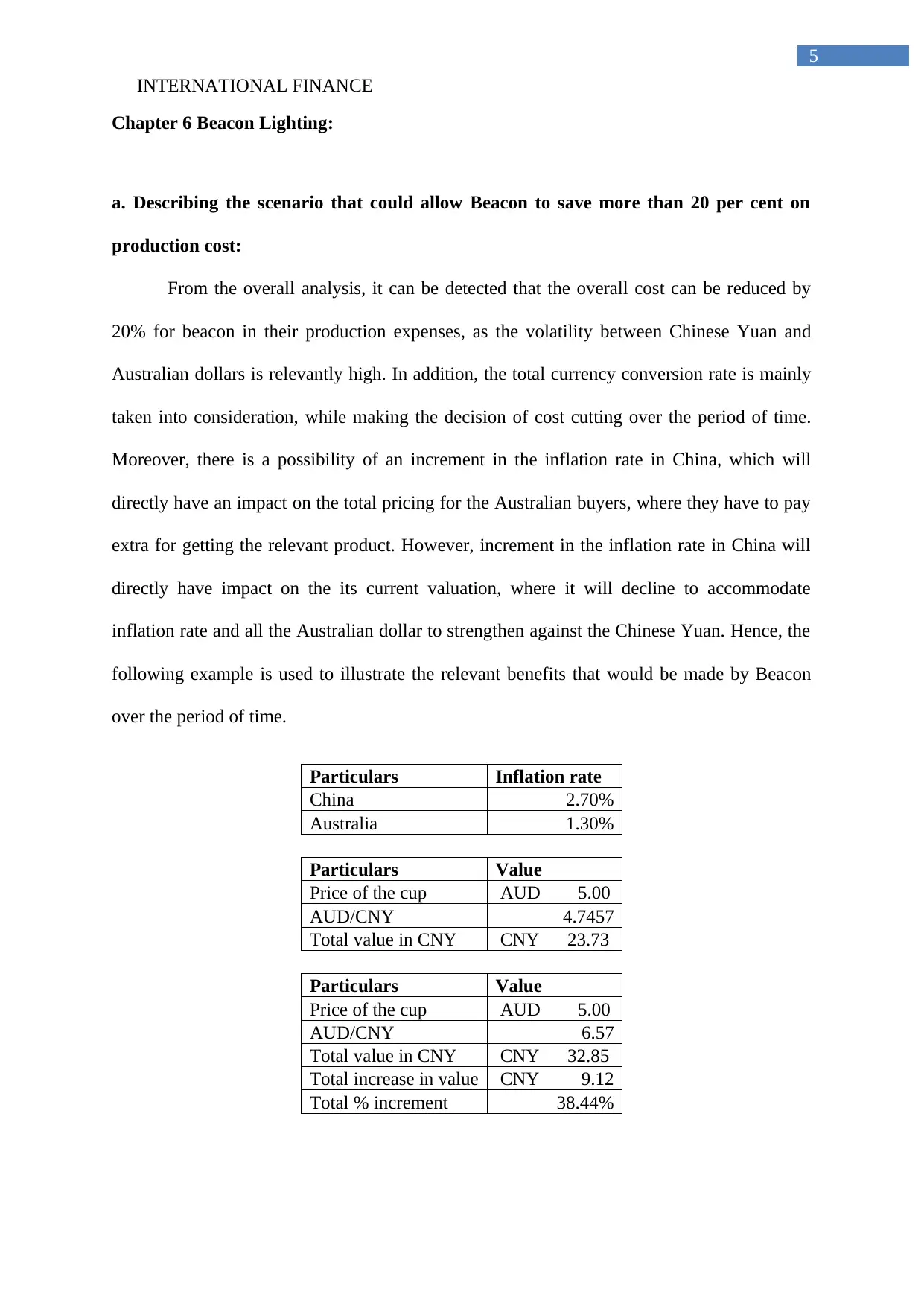
INTERNATIONAL FINANCE
5
Chapter 6 Beacon Lighting:
a. Describing the scenario that could allow Beacon to save more than 20 per cent on
production cost:
From the overall analysis, it can be detected that the overall cost can be reduced by
20% for beacon in their production expenses, as the volatility between Chinese Yuan and
Australian dollars is relevantly high. In addition, the total currency conversion rate is mainly
taken into consideration, while making the decision of cost cutting over the period of time.
Moreover, there is a possibility of an increment in the inflation rate in China, which will
directly have an impact on the total pricing for the Australian buyers, where they have to pay
extra for getting the relevant product. However, increment in the inflation rate in China will
directly have impact on the its current valuation, where it will decline to accommodate
inflation rate and all the Australian dollar to strengthen against the Chinese Yuan. Hence, the
following example is used to illustrate the relevant benefits that would be made by Beacon
over the period of time.
Particulars Inflation rate
China 2.70%
Australia 1.30%
Particulars Value
Price of the cup AUD 5.00
AUD/CNY 4.7457
Total value in CNY CNY 23.73
Particulars Value
Price of the cup AUD 5.00
AUD/CNY 6.57
Total value in CNY CNY 32.85
Total increase in value CNY 9.12
Total % increment 38.44%
5
Chapter 6 Beacon Lighting:
a. Describing the scenario that could allow Beacon to save more than 20 per cent on
production cost:
From the overall analysis, it can be detected that the overall cost can be reduced by
20% for beacon in their production expenses, as the volatility between Chinese Yuan and
Australian dollars is relevantly high. In addition, the total currency conversion rate is mainly
taken into consideration, while making the decision of cost cutting over the period of time.
Moreover, there is a possibility of an increment in the inflation rate in China, which will
directly have an impact on the total pricing for the Australian buyers, where they have to pay
extra for getting the relevant product. However, increment in the inflation rate in China will
directly have impact on the its current valuation, where it will decline to accommodate
inflation rate and all the Australian dollar to strengthen against the Chinese Yuan. Hence, the
following example is used to illustrate the relevant benefits that would be made by Beacon
over the period of time.
Particulars Inflation rate
China 2.70%
Australia 1.30%
Particulars Value
Price of the cup AUD 5.00
AUD/CNY 4.7457
Total value in CNY CNY 23.73
Particulars Value
Price of the cup AUD 5.00
AUD/CNY 6.57
Total value in CNY CNY 32.85
Total increase in value CNY 9.12
Total % increment 38.44%
⊘ This is a preview!⊘
Do you want full access?
Subscribe today to unlock all pages.

Trusted by 1+ million students worldwide
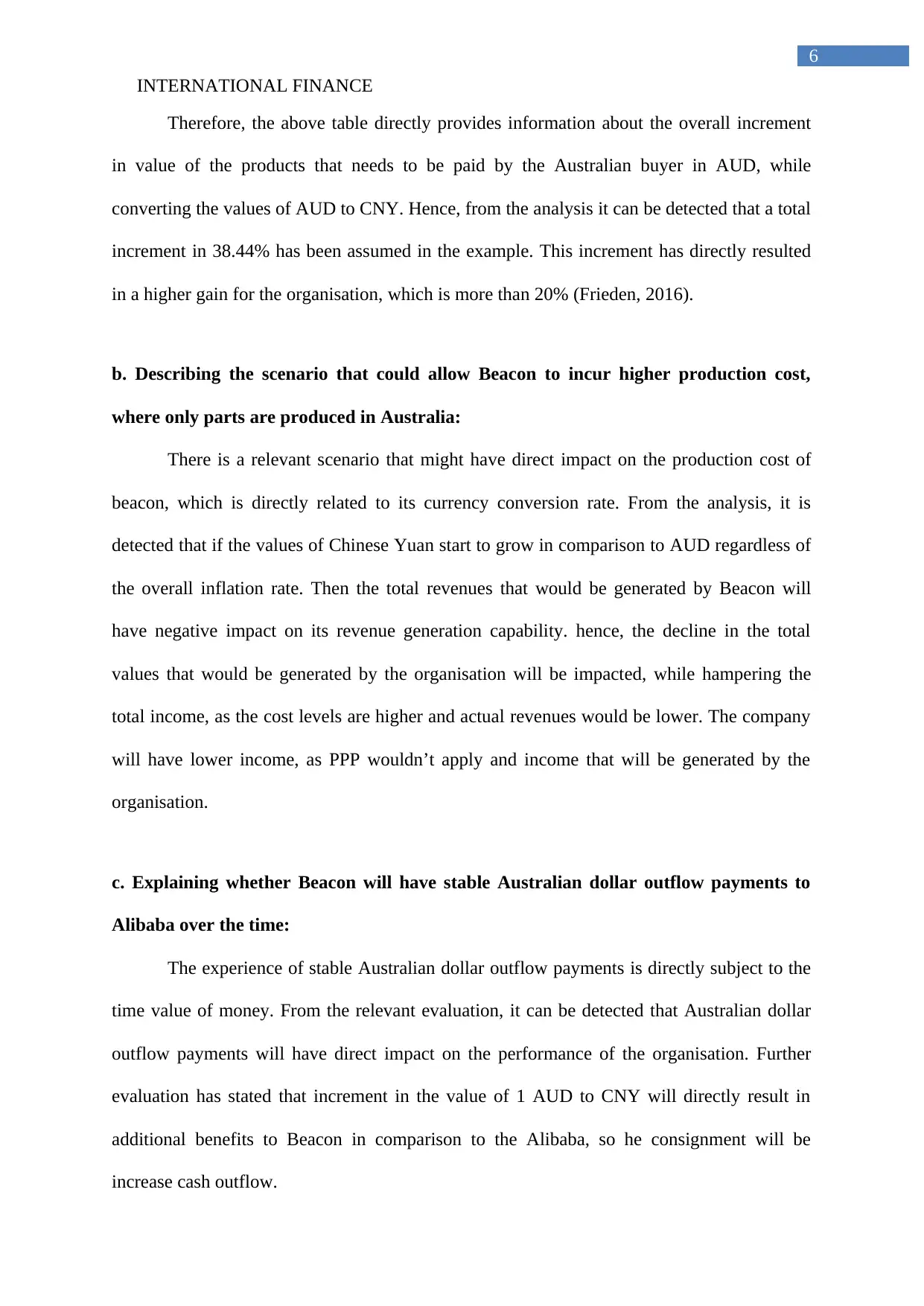
INTERNATIONAL FINANCE
6
Therefore, the above table directly provides information about the overall increment
in value of the products that needs to be paid by the Australian buyer in AUD, while
converting the values of AUD to CNY. Hence, from the analysis it can be detected that a total
increment in 38.44% has been assumed in the example. This increment has directly resulted
in a higher gain for the organisation, which is more than 20% (Frieden, 2016).
b. Describing the scenario that could allow Beacon to incur higher production cost,
where only parts are produced in Australia:
There is a relevant scenario that might have direct impact on the production cost of
beacon, which is directly related to its currency conversion rate. From the analysis, it is
detected that if the values of Chinese Yuan start to grow in comparison to AUD regardless of
the overall inflation rate. Then the total revenues that would be generated by Beacon will
have negative impact on its revenue generation capability. hence, the decline in the total
values that would be generated by the organisation will be impacted, while hampering the
total income, as the cost levels are higher and actual revenues would be lower. The company
will have lower income, as PPP wouldn’t apply and income that will be generated by the
organisation.
c. Explaining whether Beacon will have stable Australian dollar outflow payments to
Alibaba over the time:
The experience of stable Australian dollar outflow payments is directly subject to the
time value of money. From the relevant evaluation, it can be detected that Australian dollar
outflow payments will have direct impact on the performance of the organisation. Further
evaluation has stated that increment in the value of 1 AUD to CNY will directly result in
additional benefits to Beacon in comparison to the Alibaba, so he consignment will be
increase cash outflow.
6
Therefore, the above table directly provides information about the overall increment
in value of the products that needs to be paid by the Australian buyer in AUD, while
converting the values of AUD to CNY. Hence, from the analysis it can be detected that a total
increment in 38.44% has been assumed in the example. This increment has directly resulted
in a higher gain for the organisation, which is more than 20% (Frieden, 2016).
b. Describing the scenario that could allow Beacon to incur higher production cost,
where only parts are produced in Australia:
There is a relevant scenario that might have direct impact on the production cost of
beacon, which is directly related to its currency conversion rate. From the analysis, it is
detected that if the values of Chinese Yuan start to grow in comparison to AUD regardless of
the overall inflation rate. Then the total revenues that would be generated by Beacon will
have negative impact on its revenue generation capability. hence, the decline in the total
values that would be generated by the organisation will be impacted, while hampering the
total income, as the cost levels are higher and actual revenues would be lower. The company
will have lower income, as PPP wouldn’t apply and income that will be generated by the
organisation.
c. Explaining whether Beacon will have stable Australian dollar outflow payments to
Alibaba over the time:
The experience of stable Australian dollar outflow payments is directly subject to the
time value of money. From the relevant evaluation, it can be detected that Australian dollar
outflow payments will have direct impact on the performance of the organisation. Further
evaluation has stated that increment in the value of 1 AUD to CNY will directly result in
additional benefits to Beacon in comparison to the Alibaba, so he consignment will be
increase cash outflow.
Paraphrase This Document
Need a fresh take? Get an instant paraphrase of this document with our AI Paraphraser
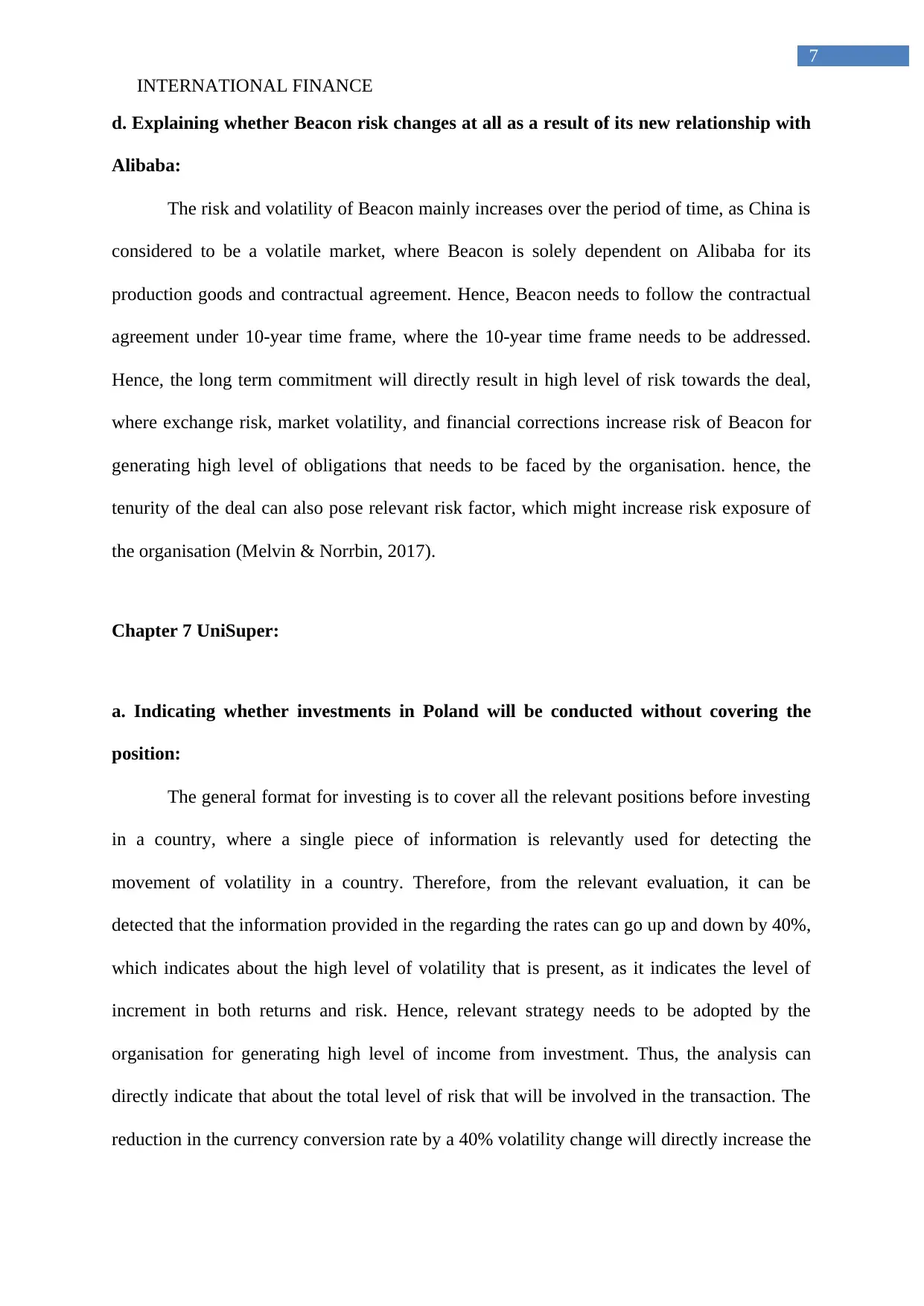
INTERNATIONAL FINANCE
7
d. Explaining whether Beacon risk changes at all as a result of its new relationship with
Alibaba:
The risk and volatility of Beacon mainly increases over the period of time, as China is
considered to be a volatile market, where Beacon is solely dependent on Alibaba for its
production goods and contractual agreement. Hence, Beacon needs to follow the contractual
agreement under 10-year time frame, where the 10-year time frame needs to be addressed.
Hence, the long term commitment will directly result in high level of risk towards the deal,
where exchange risk, market volatility, and financial corrections increase risk of Beacon for
generating high level of obligations that needs to be faced by the organisation. hence, the
tenurity of the deal can also pose relevant risk factor, which might increase risk exposure of
the organisation (Melvin & Norrbin, 2017).
Chapter 7 UniSuper:
a. Indicating whether investments in Poland will be conducted without covering the
position:
The general format for investing is to cover all the relevant positions before investing
in a country, where a single piece of information is relevantly used for detecting the
movement of volatility in a country. Therefore, from the relevant evaluation, it can be
detected that the information provided in the regarding the rates can go up and down by 40%,
which indicates about the high level of volatility that is present, as it indicates the level of
increment in both returns and risk. Hence, relevant strategy needs to be adopted by the
organisation for generating high level of income from investment. Thus, the analysis can
directly indicate that about the total level of risk that will be involved in the transaction. The
reduction in the currency conversion rate by a 40% volatility change will directly increase the
7
d. Explaining whether Beacon risk changes at all as a result of its new relationship with
Alibaba:
The risk and volatility of Beacon mainly increases over the period of time, as China is
considered to be a volatile market, where Beacon is solely dependent on Alibaba for its
production goods and contractual agreement. Hence, Beacon needs to follow the contractual
agreement under 10-year time frame, where the 10-year time frame needs to be addressed.
Hence, the long term commitment will directly result in high level of risk towards the deal,
where exchange risk, market volatility, and financial corrections increase risk of Beacon for
generating high level of obligations that needs to be faced by the organisation. hence, the
tenurity of the deal can also pose relevant risk factor, which might increase risk exposure of
the organisation (Melvin & Norrbin, 2017).
Chapter 7 UniSuper:
a. Indicating whether investments in Poland will be conducted without covering the
position:
The general format for investing is to cover all the relevant positions before investing
in a country, where a single piece of information is relevantly used for detecting the
movement of volatility in a country. Therefore, from the relevant evaluation, it can be
detected that the information provided in the regarding the rates can go up and down by 40%,
which indicates about the high level of volatility that is present, as it indicates the level of
increment in both returns and risk. Hence, relevant strategy needs to be adopted by the
organisation for generating high level of income from investment. Thus, the analysis can
directly indicate that about the total level of risk that will be involved in the transaction. The
reduction in the currency conversion rate by a 40% volatility change will directly increase the
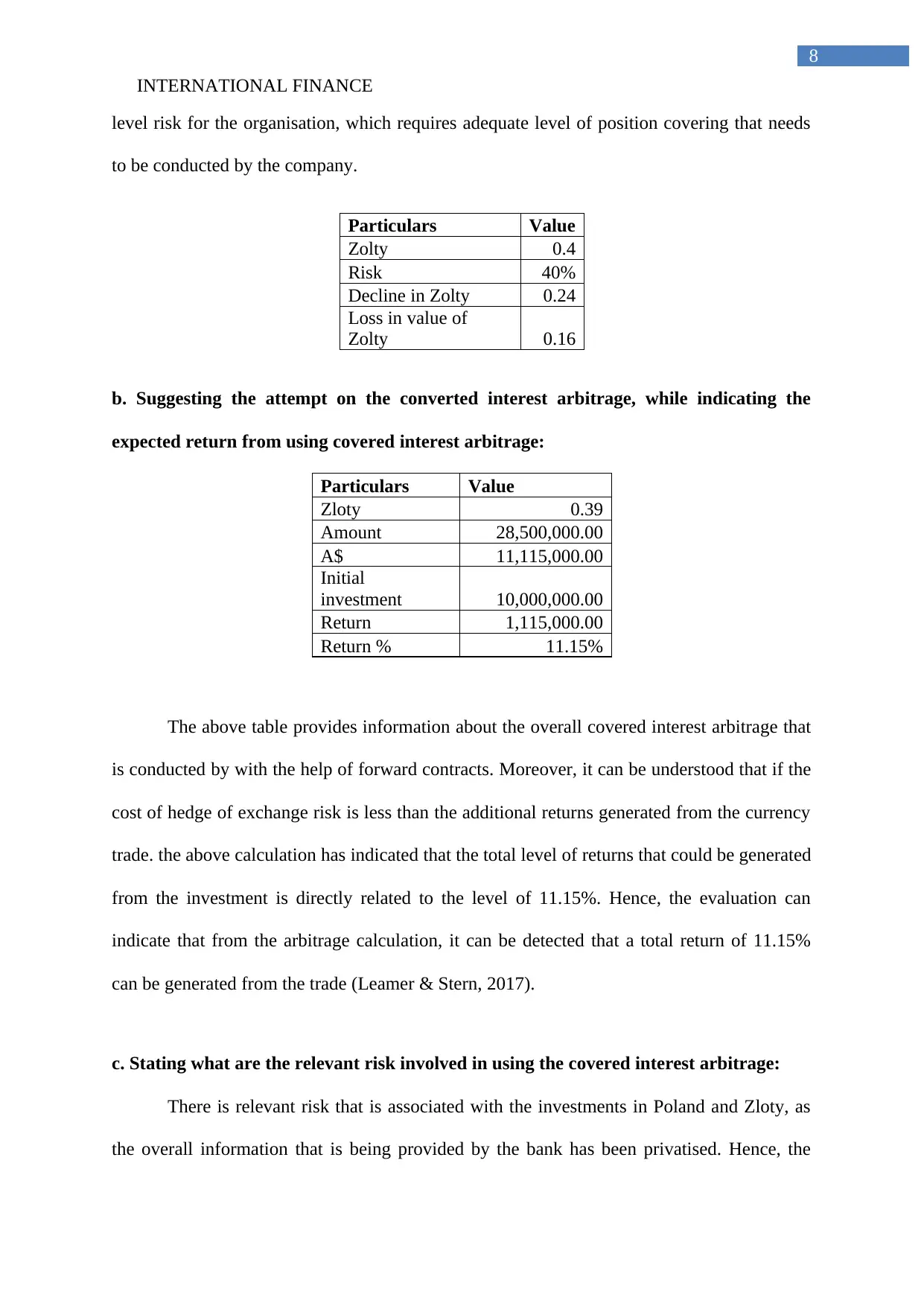
INTERNATIONAL FINANCE
8
level risk for the organisation, which requires adequate level of position covering that needs
to be conducted by the company.
Particulars Value
Zolty 0.4
Risk 40%
Decline in Zolty 0.24
Loss in value of
Zolty 0.16
b. Suggesting the attempt on the converted interest arbitrage, while indicating the
expected return from using covered interest arbitrage:
Particulars Value
Zloty 0.39
Amount 28,500,000.00
A$ 11,115,000.00
Initial
investment 10,000,000.00
Return 1,115,000.00
Return % 11.15%
The above table provides information about the overall covered interest arbitrage that
is conducted by with the help of forward contracts. Moreover, it can be understood that if the
cost of hedge of exchange risk is less than the additional returns generated from the currency
trade. the above calculation has indicated that the total level of returns that could be generated
from the investment is directly related to the level of 11.15%. Hence, the evaluation can
indicate that from the arbitrage calculation, it can be detected that a total return of 11.15%
can be generated from the trade (Leamer & Stern, 2017).
c. Stating what are the relevant risk involved in using the covered interest arbitrage:
There is relevant risk that is associated with the investments in Poland and Zloty, as
the overall information that is being provided by the bank has been privatised. Hence, the
8
level risk for the organisation, which requires adequate level of position covering that needs
to be conducted by the company.
Particulars Value
Zolty 0.4
Risk 40%
Decline in Zolty 0.24
Loss in value of
Zolty 0.16
b. Suggesting the attempt on the converted interest arbitrage, while indicating the
expected return from using covered interest arbitrage:
Particulars Value
Zloty 0.39
Amount 28,500,000.00
A$ 11,115,000.00
Initial
investment 10,000,000.00
Return 1,115,000.00
Return % 11.15%
The above table provides information about the overall covered interest arbitrage that
is conducted by with the help of forward contracts. Moreover, it can be understood that if the
cost of hedge of exchange risk is less than the additional returns generated from the currency
trade. the above calculation has indicated that the total level of returns that could be generated
from the investment is directly related to the level of 11.15%. Hence, the evaluation can
indicate that from the arbitrage calculation, it can be detected that a total return of 11.15%
can be generated from the trade (Leamer & Stern, 2017).
c. Stating what are the relevant risk involved in using the covered interest arbitrage:
There is relevant risk that is associated with the investments in Poland and Zloty, as
the overall information that is being provided by the bank has been privatised. Hence, the
⊘ This is a preview!⊘
Do you want full access?
Subscribe today to unlock all pages.

Trusted by 1+ million students worldwide
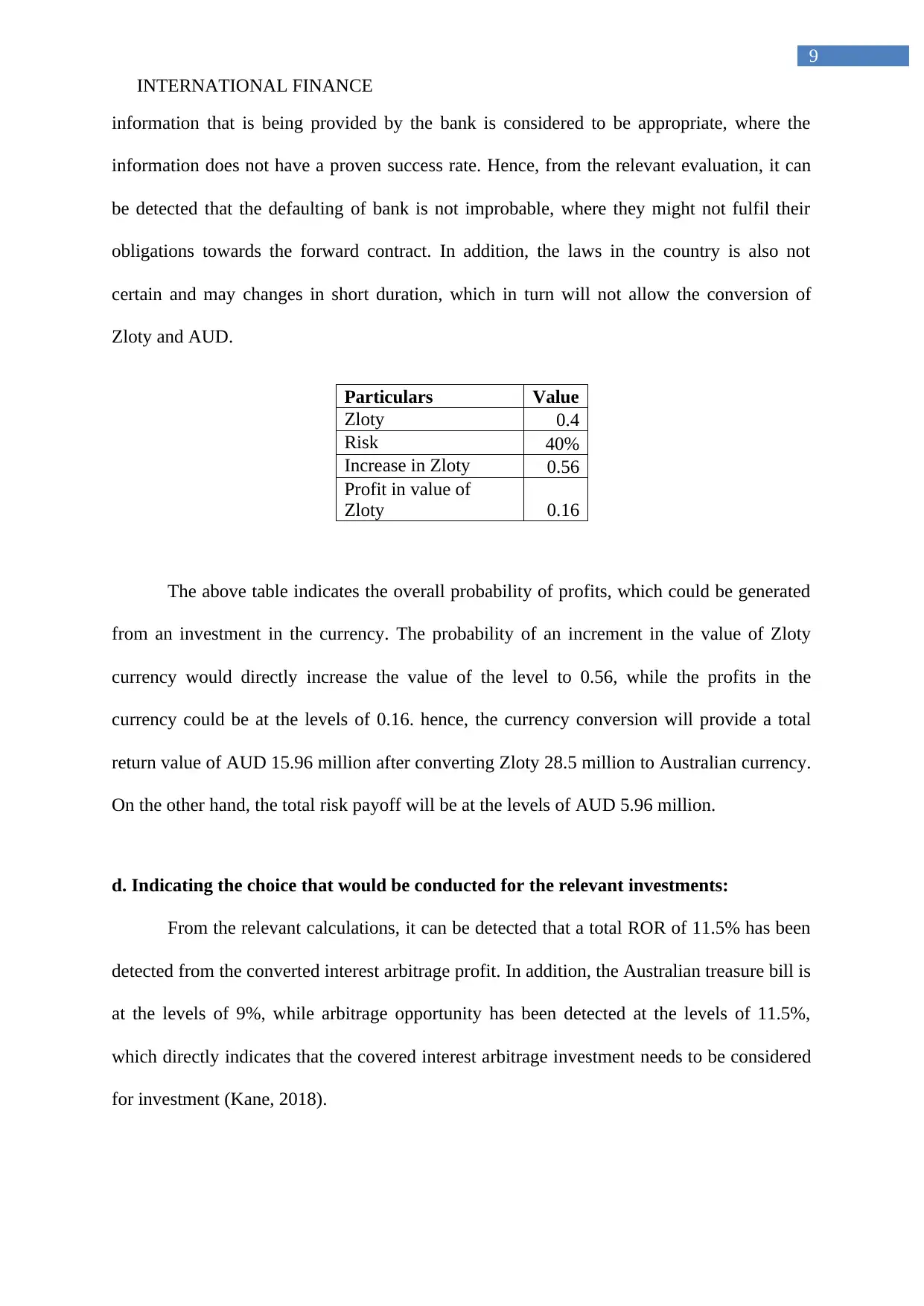
INTERNATIONAL FINANCE
9
information that is being provided by the bank is considered to be appropriate, where the
information does not have a proven success rate. Hence, from the relevant evaluation, it can
be detected that the defaulting of bank is not improbable, where they might not fulfil their
obligations towards the forward contract. In addition, the laws in the country is also not
certain and may changes in short duration, which in turn will not allow the conversion of
Zloty and AUD.
Particulars Value
Zloty 0.4
Risk 40%
Increase in Zloty 0.56
Profit in value of
Zloty 0.16
The above table indicates the overall probability of profits, which could be generated
from an investment in the currency. The probability of an increment in the value of Zloty
currency would directly increase the value of the level to 0.56, while the profits in the
currency could be at the levels of 0.16. hence, the currency conversion will provide a total
return value of AUD 15.96 million after converting Zloty 28.5 million to Australian currency.
On the other hand, the total risk payoff will be at the levels of AUD 5.96 million.
d. Indicating the choice that would be conducted for the relevant investments:
From the relevant calculations, it can be detected that a total ROR of 11.5% has been
detected from the converted interest arbitrage profit. In addition, the Australian treasure bill is
at the levels of 9%, while arbitrage opportunity has been detected at the levels of 11.5%,
which directly indicates that the covered interest arbitrage investment needs to be considered
for investment (Kane, 2018).
9
information that is being provided by the bank is considered to be appropriate, where the
information does not have a proven success rate. Hence, from the relevant evaluation, it can
be detected that the defaulting of bank is not improbable, where they might not fulfil their
obligations towards the forward contract. In addition, the laws in the country is also not
certain and may changes in short duration, which in turn will not allow the conversion of
Zloty and AUD.
Particulars Value
Zloty 0.4
Risk 40%
Increase in Zloty 0.56
Profit in value of
Zloty 0.16
The above table indicates the overall probability of profits, which could be generated
from an investment in the currency. The probability of an increment in the value of Zloty
currency would directly increase the value of the level to 0.56, while the profits in the
currency could be at the levels of 0.16. hence, the currency conversion will provide a total
return value of AUD 15.96 million after converting Zloty 28.5 million to Australian currency.
On the other hand, the total risk payoff will be at the levels of AUD 5.96 million.
d. Indicating the choice that would be conducted for the relevant investments:
From the relevant calculations, it can be detected that a total ROR of 11.5% has been
detected from the converted interest arbitrage profit. In addition, the Australian treasure bill is
at the levels of 9%, while arbitrage opportunity has been detected at the levels of 11.5%,
which directly indicates that the covered interest arbitrage investment needs to be considered
for investment (Kane, 2018).
Paraphrase This Document
Need a fresh take? Get an instant paraphrase of this document with our AI Paraphraser
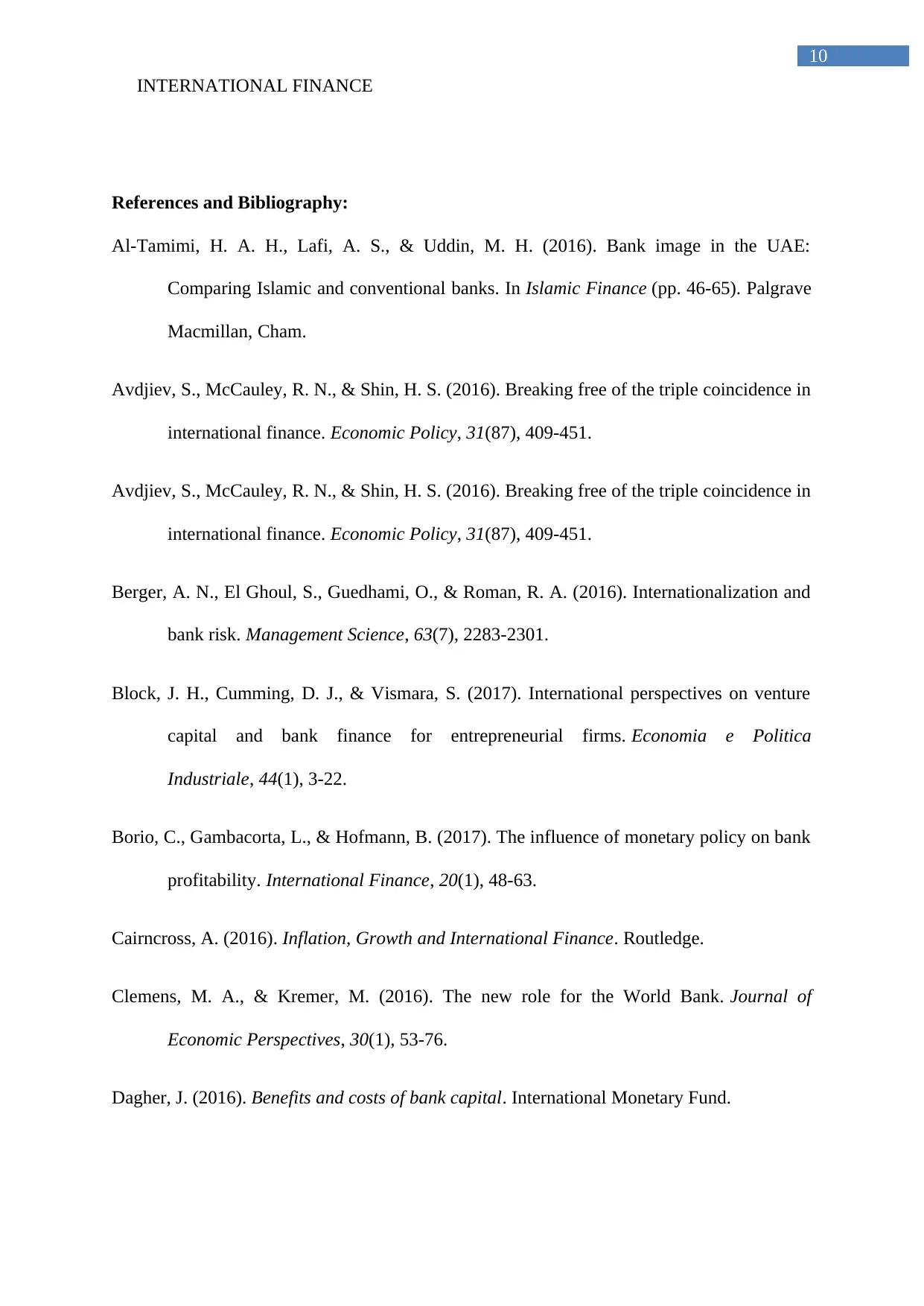
INTERNATIONAL FINANCE
10
References and Bibliography:
Al-Tamimi, H. A. H., Lafi, A. S., & Uddin, M. H. (2016). Bank image in the UAE:
Comparing Islamic and conventional banks. In Islamic Finance (pp. 46-65). Palgrave
Macmillan, Cham.
Avdjiev, S., McCauley, R. N., & Shin, H. S. (2016). Breaking free of the triple coincidence in
international finance. Economic Policy, 31(87), 409-451.
Avdjiev, S., McCauley, R. N., & Shin, H. S. (2016). Breaking free of the triple coincidence in
international finance. Economic Policy, 31(87), 409-451.
Berger, A. N., El Ghoul, S., Guedhami, O., & Roman, R. A. (2016). Internationalization and
bank risk. Management Science, 63(7), 2283-2301.
Block, J. H., Cumming, D. J., & Vismara, S. (2017). International perspectives on venture
capital and bank finance for entrepreneurial firms. Economia e Politica
Industriale, 44(1), 3-22.
Borio, C., Gambacorta, L., & Hofmann, B. (2017). The influence of monetary policy on bank
profitability. International Finance, 20(1), 48-63.
Cairncross, A. (2016). Inflation, Growth and International Finance. Routledge.
Clemens, M. A., & Kremer, M. (2016). The new role for the World Bank. Journal of
Economic Perspectives, 30(1), 53-76.
Dagher, J. (2016). Benefits and costs of bank capital. International Monetary Fund.
10
References and Bibliography:
Al-Tamimi, H. A. H., Lafi, A. S., & Uddin, M. H. (2016). Bank image in the UAE:
Comparing Islamic and conventional banks. In Islamic Finance (pp. 46-65). Palgrave
Macmillan, Cham.
Avdjiev, S., McCauley, R. N., & Shin, H. S. (2016). Breaking free of the triple coincidence in
international finance. Economic Policy, 31(87), 409-451.
Avdjiev, S., McCauley, R. N., & Shin, H. S. (2016). Breaking free of the triple coincidence in
international finance. Economic Policy, 31(87), 409-451.
Berger, A. N., El Ghoul, S., Guedhami, O., & Roman, R. A. (2016). Internationalization and
bank risk. Management Science, 63(7), 2283-2301.
Block, J. H., Cumming, D. J., & Vismara, S. (2017). International perspectives on venture
capital and bank finance for entrepreneurial firms. Economia e Politica
Industriale, 44(1), 3-22.
Borio, C., Gambacorta, L., & Hofmann, B. (2017). The influence of monetary policy on bank
profitability. International Finance, 20(1), 48-63.
Cairncross, A. (2016). Inflation, Growth and International Finance. Routledge.
Clemens, M. A., & Kremer, M. (2016). The new role for the World Bank. Journal of
Economic Perspectives, 30(1), 53-76.
Dagher, J. (2016). Benefits and costs of bank capital. International Monetary Fund.
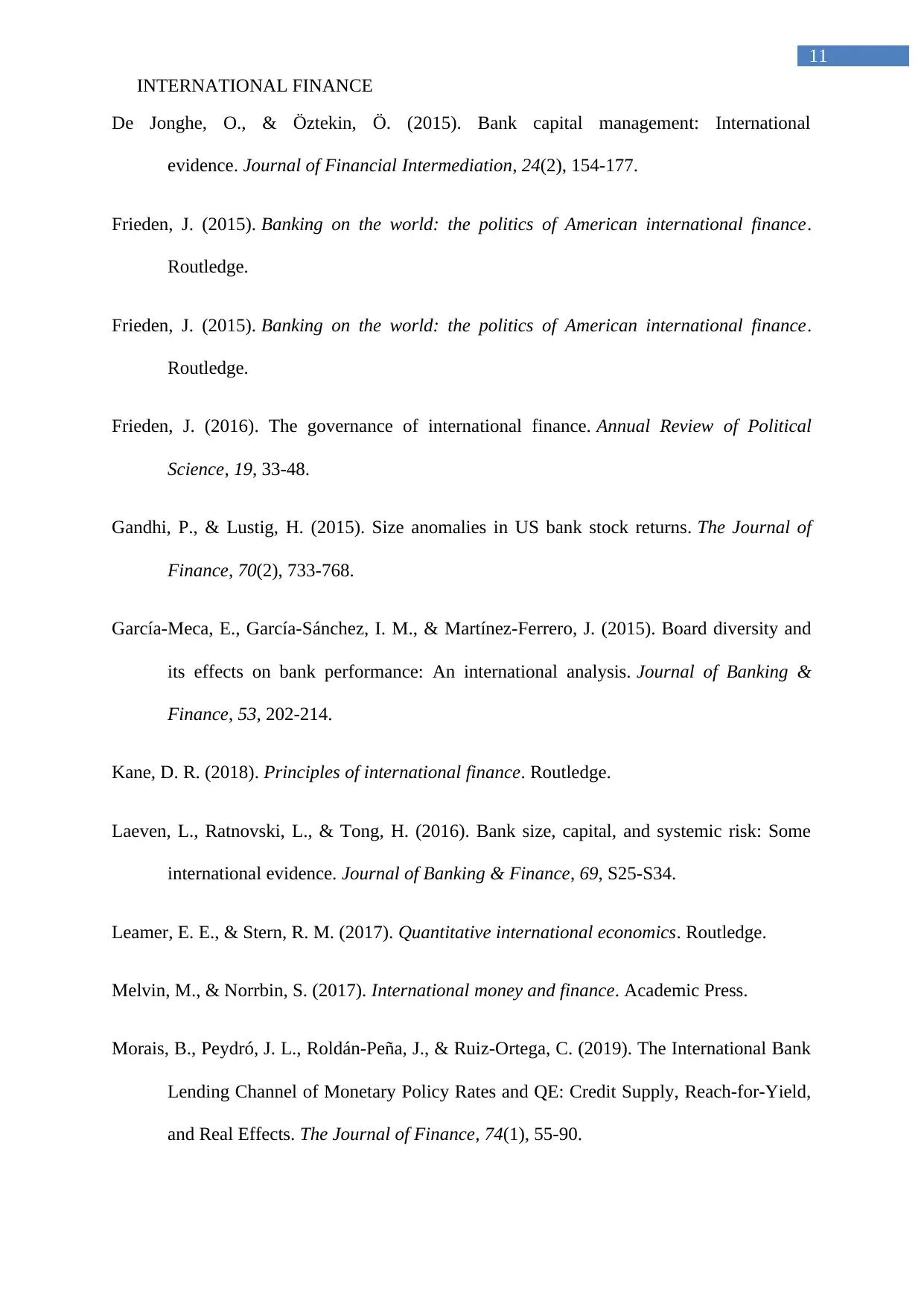
INTERNATIONAL FINANCE
11
De Jonghe, O., & Öztekin, Ö. (2015). Bank capital management: International
evidence. Journal of Financial Intermediation, 24(2), 154-177.
Frieden, J. (2015). Banking on the world: the politics of American international finance.
Routledge.
Frieden, J. (2015). Banking on the world: the politics of American international finance.
Routledge.
Frieden, J. (2016). The governance of international finance. Annual Review of Political
Science, 19, 33-48.
Gandhi, P., & Lustig, H. (2015). Size anomalies in US bank stock returns. The Journal of
Finance, 70(2), 733-768.
García-Meca, E., García-Sánchez, I. M., & Martínez-Ferrero, J. (2015). Board diversity and
its effects on bank performance: An international analysis. Journal of Banking &
Finance, 53, 202-214.
Kane, D. R. (2018). Principles of international finance. Routledge.
Laeven, L., Ratnovski, L., & Tong, H. (2016). Bank size, capital, and systemic risk: Some
international evidence. Journal of Banking & Finance, 69, S25-S34.
Leamer, E. E., & Stern, R. M. (2017). Quantitative international economics. Routledge.
Melvin, M., & Norrbin, S. (2017). International money and finance. Academic Press.
Morais, B., Peydró, J. L., Roldán‐Peña, J., & Ruiz‐Ortega, C. (2019). The International Bank
Lending Channel of Monetary Policy Rates and QE: Credit Supply, Reach‐for‐Yield,
and Real Effects. The Journal of Finance, 74(1), 55-90.
11
De Jonghe, O., & Öztekin, Ö. (2015). Bank capital management: International
evidence. Journal of Financial Intermediation, 24(2), 154-177.
Frieden, J. (2015). Banking on the world: the politics of American international finance.
Routledge.
Frieden, J. (2015). Banking on the world: the politics of American international finance.
Routledge.
Frieden, J. (2016). The governance of international finance. Annual Review of Political
Science, 19, 33-48.
Gandhi, P., & Lustig, H. (2015). Size anomalies in US bank stock returns. The Journal of
Finance, 70(2), 733-768.
García-Meca, E., García-Sánchez, I. M., & Martínez-Ferrero, J. (2015). Board diversity and
its effects on bank performance: An international analysis. Journal of Banking &
Finance, 53, 202-214.
Kane, D. R. (2018). Principles of international finance. Routledge.
Laeven, L., Ratnovski, L., & Tong, H. (2016). Bank size, capital, and systemic risk: Some
international evidence. Journal of Banking & Finance, 69, S25-S34.
Leamer, E. E., & Stern, R. M. (2017). Quantitative international economics. Routledge.
Melvin, M., & Norrbin, S. (2017). International money and finance. Academic Press.
Morais, B., Peydró, J. L., Roldán‐Peña, J., & Ruiz‐Ortega, C. (2019). The International Bank
Lending Channel of Monetary Policy Rates and QE: Credit Supply, Reach‐for‐Yield,
and Real Effects. The Journal of Finance, 74(1), 55-90.
⊘ This is a preview!⊘
Do you want full access?
Subscribe today to unlock all pages.

Trusted by 1+ million students worldwide
1 out of 13
Related Documents
Your All-in-One AI-Powered Toolkit for Academic Success.
+13062052269
info@desklib.com
Available 24*7 on WhatsApp / Email
![[object Object]](/_next/static/media/star-bottom.7253800d.svg)
Unlock your academic potential
Copyright © 2020–2025 A2Z Services. All Rights Reserved. Developed and managed by ZUCOL.



